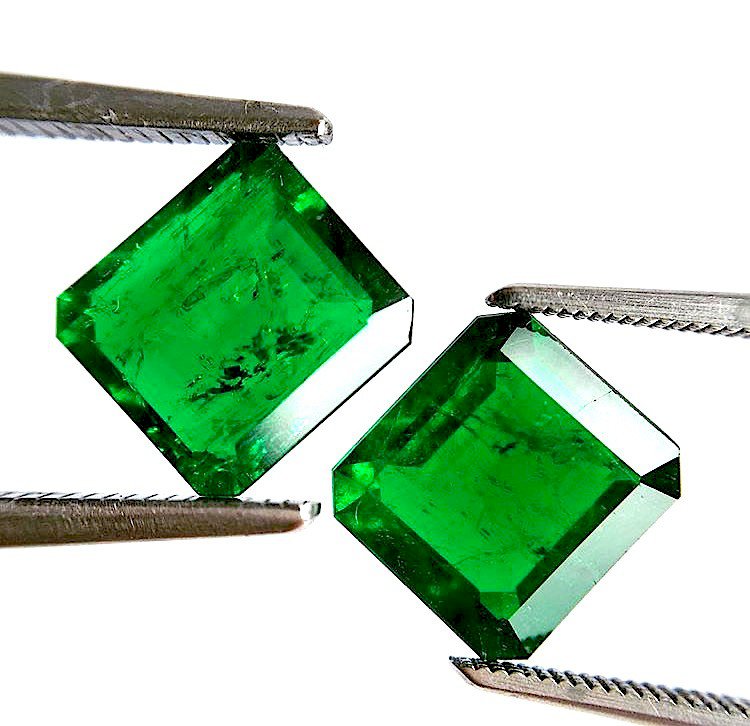The Use of Oil in the Treatment of Emeralds
Most polished emeralds undergo some treatment.

The refining process and its impact on prices.
It is human nature to strive for excellence, and this aspiration extends far beyond self-image.
We strive to refine just about everything created by Mother Nature, everything that is beautiful in its own natural form - including precious stones.
The richer the color and the purer the mineral, the better, and this epithet is true for any precious stone.
So, in search of possessing the treasures of nature, which can reap great financial rewards, people began thousands of years ago to refine emeralds in a very simple way: lubrication. And to this day, oil treatment is still the most common method used to improve the appearance of emeralds.
Of all the clear gem quality crystals mined around the world, on all continents, there are very few "gem quality" emeralds.
In fact, the highest quality green beryl stones are graced with complex internal crystalline structures, known as “garden type” inclusions.
Despite the fact that a stone with attractive defects is occasionally valued at values not inferior to those of its defect-free counterparts with its thick and smooth color, we try, however, to correct the natural “mistakes” in the defective stone, doing what we it seems to be unattractive a little less noticeable. This is achieved by filling emeralds along possible fault lines with cedar oil or natural resin, known as "Canadian balm".

“Since ancient Egypt, the fracture process filling this wonderful gemstone has been documented on parchments and other ancient texts. Typically, the preferred method for improving the clarity of an emerald is to fill natural cracks and fractures with natural cedar oil or Canadian balm, although there are other, more permanent methods.
Unlike the treatment applied to sapphires and rubies, most ways to improve the aesthetic appearance of an emerald are reversible. So, if emeralds in oil is just a temporary solution, why is it still the most common treatment?
As this viscous liquid has the unique property of being able to penetrate even the smallest cracks and imperfections and does so crucially because of its refractive index (almost identical). The natural oil becomes like a kind of glue, displacing the air from the cracks, dissolving debris and cementing the crystals into separate parts.
“The levels or degrees of treatment are established by the LMHC (Lapidary Manual Harmonization Committee) and divided into categories: no oil / insignificant and then minor, moderate and significant treatment. Stones in the first (secondary) category usually require a small amount of oil to make them reach their full potential. It may be that only one surface reaching the crack has been filled.
The next moderate level of treatment includes stones with multiple cracks reaching the surface, one or more of which will be located on the emerald table. And the last category is composed of stones with several fractures filled with oil, many of which reach the surface.
The green emerald jewelry in the windows of Van Cleef & Arpels, Chopard, Boucheron, Cartier and other top brands will almost certainly have little or no treatment. Over the years, the gemologists of the main jewelers sought stones for their collections and never compromised with the quality of the jewelry. For premium jewelry pieces, you will have to pay the price; therefore, if you are looking for more affordable emeralds, contact medium boutiques or lesser-known brands. They usually work with refined emeralds to a moderate degree.
Despite the fact that oiled emeralds make them more visually appealing, their value suffers. "Using a 3-carat stone of great color and clarity as an example, with all things except the same level of treatment, we can explore the effect that this has on the value of an emerald.

Emeralds with no indication of improved clarity that do not require fracture filling to improve appearance require huge rewards over their counterparts. If a stone is classified as showing 'minor' indications for improving clarity, prices can range from $ 12,000 to $ 18,000 per carat.
If it belongs to the "moderate" category, the value ranges from $ 8,000 to $ 12,000 per carat. Finally, an emerald exhibiting "significant" indications for treatment can be worth $ 4,000 to $ 6,000 per carat.
These prices are just an approximate guide, as there are several other factors that affect prices ”, explains George. If you can find a completely natural emerald, be prepared to pay a high price for it: these stones are so rare that Smith estimates that they constitute a mere 0.5% of the market.

And finally, it is also worth talking about the certificates, because they are your guarantee of quality. The most respectable and reliable are the two Swiss laboratories, Gubelin and SSEF, which carry out the inspection, analysis and certification of most of the good quality Colombian emeralds on the market (including many emeralds supplied by IEEX). However, they do not indicate in the certificate what type of refining process was implemented, paying attention only to the degree of improvement undergone by the emeralds.
“They refuse to specify the exact type of treatment agent not because they cannot be identified, but because these laboratories only state in writing what they can say with 100% accuracy. The lack of a crack treated with a different filling material can compromise the reputation of the laboratories. SSEF is the only Swiss laboratory that provides any indication of the type of treatment, classifying it as "traditional" or "modern" ",
This is usually done prior to the cutting process to ensure that any rough stones (which would normally have many fractures and are therefore structurally weak) are able to survive the pressure of the cutting and polishing wheel. For this reason, IEEX employs an oil-only policy, working only with good quality products. Any reputable dealer should disclose the exact type of treatment that an emerald may have undergone, preferably in
To summarize, cedar oil is 100% natural and, as such, is the most traditional and favored way of treating an emerald. Normally, a stone with a minimal amount of treatment should never require lubrication, but in recent years many retailers have started using artificial hardened resins (which are essentially synthetic 'glue') to fracture emeralds, in the hope of providing a more permanent appearance. treatment for stones that require a lot.


